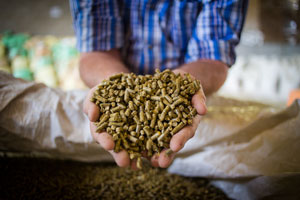
Written by: Lara Moody | August 30, 2022
 There is a growing interest for animal food companies to better understand the impacts of their operations and supply chains to identify market opportunities and meet expectations of downstream stakeholders. Utilizing life cycle assessment (LCA) tools are a great way to assess the footprint of operations and existing product lines. They can also be used to innovate and seize on growing demand for sustainable products in the marketplace.
There is a growing interest for animal food companies to better understand the impacts of their operations and supply chains to identify market opportunities and meet expectations of downstream stakeholders. Utilizing life cycle assessment (LCA) tools are a great way to assess the footprint of operations and existing product lines. They can also be used to innovate and seize on growing demand for sustainable products in the marketplace.
LCAs are a tool for assessing the environmental impacts associated with a product over its lifecycle – from production, to transportation, to processing, to its end use. They can help prioritize improvements on products or processes and can be an important tool for comparing environmental tradeoffs and benefits of different products for internal decision making.
In support of the upcoming Feed Systems Sustainability Summit, the Institute for Feed Education and Research (IFEEDER) and World Wildlife Fund (WWF) recently hosted a webinar exploring the use of LCA tools. Speakers Martin Guthrie, corporate director of environmental affairs for Darling Ingredients; Erica Lain, sustainability manager for Iowa Select Farms; and Tom Battagliese, senior manager global sustainability metrics for BASF offered insights into their organizations use of LCAs and data.
Here are my three takeaways from the discussion.
LCAs provide insights into the environmental impacts of operations and supply chains to help companies better understand “hot spots” as well as where to allocate resources for improvement. Below are three, real-life examples of how LCAs have helped inform decision making in the feed industry:
LCAs, a mainstay in European sustainability efforts, are now a growing trend in the United States to support both customer and consumer demands for accountability and transparency in the supply chain.
Battagliese confirmed that the demand for LCAs in Europe is here and now, with many of their customers actively using them as an approach for communicating and tracking. In the U.S., it’s coming on quickly from a market-driven perspective, whereas the early push in Europe was policy driven.
Guthrie agreed, noting that Darling Ingredients recently started seeing increased demand in the U.S. for this kind of data down through their supply chain to the final manufacturers. Whereas in Europe, their LCA data sets have been utilized for several years as a tool to set goals, as this data informs where to focus to improve energy and water usage.
Iowa Select Farms aims to capitalize on this new interest in LCAs to ensure alignment with their whole supply chain. As a customer-driven company, they know the importance of evolving with the needs of their stakeholders. They see sustainability efforts as a mainstay for their customers and consumers and want to continue moving forward by supporting their needs.
LCAs can be developed from both primary (i.e., specific) and secondary (i.e., generic) data sets. The greater the use of primary data, the more accurate the LCA becomes. Working to improve the data set a company uses for its LCA can provide a more accurate, and possibly lower, environmental impact assessment.
As Battagliese points out, data sources are important because data being used to drive decisions at a product level gets rolled up to decisions at the enterprise level. We’re all setting corporate goals, but a lot of organizations haven’t yet realized how to achieve those goals. Ultimately, a footprint is comprised of every product that is made, so without assessing at a product-level life cycle perspective, companies will never be able to achieve innovations necessary to connect at the enterprise level.
At Darling Ingredients, LCAs have informed their ability to obtain better and more useful data. As the company works to improve its unit processes, it needs to get more granular on where energy is used, which helps it further divide those processes within a facility. The process of increasing the use of water flow meters and energy measurements throughout the facility is an improvement that allows the company to get better, more specific primary data.
For Iowa Select Farms, completing an LCA unveiled opportunities to collect and look at more accurate data throughout their feed system, but also through other systems within the business, such as water and energy usage. Lain indicated a potential to improve their LCA values by 40%, specific to their feed footprint, if they could obtain more specific primary data sets. Currently, they are looking at ways to be more efficient with data collection through technology.
The full webinar, along with an abridged highlights version, can be found on IFEEDER’s website.
To take part in the conversation, you can join IFEEDER and WWF for the next installment of the summer webinar series on Sept. 15, “Feeding Future Sustainable Protein Systems.” Register here>>
Comments See our policy on comments